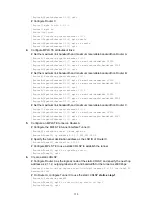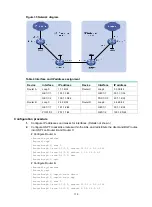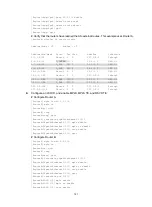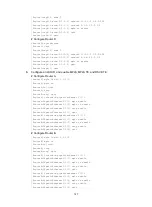
112
Affinity Attr/Mask : -/-
Explicit Path : -
Backup Explicit Path : -
Metric Type : TE
Record Route : - Record Label : -
FRR Flag : - Bandwidth Protection : -
Backup Bandwidth Flag: - Backup Bandwidth Type: -
Backup Bandwidth : -
Bypass Tunnel : - Auto Created : -
Route Pinning : -
Retry Limit : 3 Retry Interval : 2 sec
Reoptimization : - Reoptimization Freq : -
Backup Type : - Backup LSP ID : -
Auto Bandwidth : - Auto Bandwidth Freq : -
Min Bandwidth : - Max Bandwidth : -
Collected Bandwidth : -
# Display static CRLSP information on each router.
[RouterA] display mpls lsp
FEC Proto In/Out Label Interface/Out NHLFE
1.1.1.1/0/1 StaticCR -/20 GE1/1/1
2.1.1.2 Local -/- GE1/1/1
Tunnel0 Local -/- NHLFE1025
[RouterB] display mpls lsp
FEC Proto In/Out Label Interface/Out NHLFE
- StaticCR 20/30 GE1/1/2
3.2.1.2 Local -/- GE1/1/2
[RouterC] display mpls lsp
FEC Proto In/Out Label Interface/Out NHLFE
- StaticCR 30/- -
[RouterA] display mpls static-cr-lsp
Name LSR Type In/Out Label Out Interface State
static-cr-lsp-1 Ingress Null/20 GE1/1/1 Up
[RouterB] display mpls static-cr-lsp
Name LSR Type In/Out Label Out Interface State
static-cr-lsp-1 Transit 20/30 GE1/1/2 Up
[RouterC] display mpls static-cr-lsp
Name LSR Type In/Out Label Out Interface State
static-cr-lsp-1 Egress 30/Null - Up
# Execute the
display ip routing-table
command on Router A. The output shows a static route entry
with interface Tunnel 0 as the output interface. (Details not shown.)
Establishing an MPLS TE tunnel with RSVP-TE
Network requirements
Router A, Router B, Router C, and Router D run IS-IS and all of them are Level-2 routers.
Use RSVP-TE to establish an MPLS TE tunnel from Router A to Router D to transmit data between
the two IP networks. The MPLS TE tunnel requires a bandwidth of 2000 kbps.






























